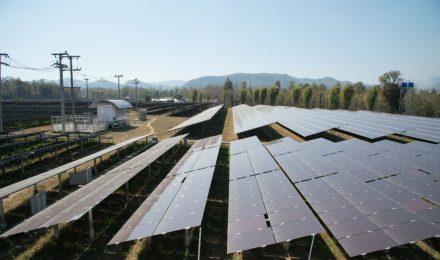One of the most popular renewable sources of energy is solar. The production and use of solar energy have a negligible carbon footprint, which makes it an environmentally friendly source of power that has been researched for decades. However, there is a potential environmental impact associated with the process. Water consumes a significant proportion of the energy produced by the sun — it is estimated that up to one-third of all power generated by solar panels can be lost due to the evaporation of water. This wasted energy is in addition to water use’s effect on the environment.
Solar water heaters (SWT) consume significantly less energy than fossil fuel-based equivalent systems, but they still significantly contribute to water consumption. In temperate climates, SWT systems use 15–25% of total domestic hot-water demand, while in tropical climates, they can consume between 50–60%, depending on their efficiency. While these percentages are comparable to those for fossil fuel use, it is the water that is used that is relatively unchanged.
One reason for this discrepancy is the energy used to evaporate and condense air, which can account for up to 40% of a SWT system’s energy needs. The SWT loses 35% of the heat produced by conduction to the surface and about 10% of thermal energy due to convection. Since water-based systems utilize a lot of thermal energy to have the same amount of useful power, the requirements for water resources are greater than those for fossil fuel plants.
Power comes from various sources, including fossil fuels, nuclear reactors (thermal and fission), hydroelectric dams, geothermal plants, wind farms, solar PV/PVH systems and other renewable energy resources. Fossil-fuel use is combustion with some extraction to purify the fuel – nuclear power is mainly generated using fission (thermal) processes. Fossil-to-fossil fuel conversion ratios have been linked to the amount of CO2 emitted into the atmosphere.
The total amount of greenhouse gases directly emitted into the atmosphere as a result of the energy supply process and from fossil fuels is estimated to be roughly equal to the (CO2 + CH4) emissions released in physical conversion. While nuclear power only produces atomic waste and CO2, other renewable energy sources produce no CO2 or greenhouse gases. The total energy acquired and used by industrial processes and household products can be divided into two main categories:
This second category is then subdivided as follows:
Solar-energy-based solutions have been available across different limitations in many countries worldwide. The technologies can be deployed in off-grid locations and wholly or partially power a local area or the entire country, provided there is enough clear sky.
Solar power can produce potable water from the heat produced by the solar panels through a solar water-heating system. Every year, 1/2 trillion cubic meters of water are used for drinking worldwide. This amount of water is unavailable with traditional energy sources like fossil fuels and nuclear energy. Therefore, it must be purchased from outside sources such as natural lakes and freshwater streams (with a focused emphasis on ecological damage caused). Solar energy can help reduce the impact on natural bodies of water.
There are many advantages to having a solar water heater installed in your home or business. Savings can be made on monthly energy bill payments, and a new system can be financed for little to no money out of pocket. Solar water heaters cost about 1/2 as much as conventional systems and are usually tax deductible. There is no danger from toxic gases or high temperatures, and they do not use fossil fuels and emit greenhouse gases that can be dangerous to the environment, like groundwater supplies, etc. The government may offer rebates of up to 50% on the cost of the system, depending on your location and utility company.
The disadvantages of solar water heaters are that they require sufficient sunlight to operate and can only provide hot water on demand, which means storing it in a tank or using a tankless system. Solar water heaters are not the most efficient systems available, but the advantage is their reliability and low cost compared to fossil fuel systems.
Solar panels can also be used for commercial, industrial, and agricultural heating. The advantages of solar thermal energy include the reduction of greenhouse gases and dependence on fossil fuels. In addition, it is a renewable resource that can be used indefinitely. There are also many disadvantages, including high initial costs of installation as well as the high price of maintenance and replacement parts for older systems over 25 years old.
Solar power is one type of renewable energy, a collection of energy sources that do not deplete the reserves of resources that are available for future generations. Renewable energy comes from natural and artificial bodies such as the sun, water, wind, biofuel and geothermal heat. These sources can be used to create electricity from photovoltaics and all other forms of solar technology. Solar power can be used in residential and non-residential applications (i.e., commercial). Still, solar water heating is only typically used for residential applications because of its lower efficiency for industrial uses.
In the United States, “electricity” is regulated by the Federal Energy Regulatory Commission (FERC). At the same time, in other countries, it can be more closely held by local governments or private companies. In Germany, electricity is produced both by utility companies as well as by renewable producers. The American Public Power Association states that “the term ‘alternative energy’ is sometimes used to describe forms of energy that have been generally considered to be renewable or derived from fossil fuel; however, this term should not be used to describe any form of energy unless it is derived from such sources.”
Many countries have legislation requiring renewable energies to be powered by specific percentages of renewables. However, this needs to be sufficiently ambitious since a country with less oil and more coal reserves can only produce a fraction of its electricity from renewables. As of 2012, almost 70% of all new electricity capacity was renewable, according to Globetrotter 6 Energy.
Storage allows producers and consumers to shift usage among different energy carriers (e.g., fossil fuels, hydropower) or times of day (e.g., daytime vs nighttime). It allows energy carriers to be used more flexibly and efficiently, helping lower the cost of energy storage, reduce grid intermittency and improve overall market efficiency. It can also be a safety mechanism in case one system becomes disabled.
Many types of storage systems are developed, including pumped hydro, compressed air energy storage (CAES), thermal storage and cold fusion. Each has its advantages, costs and trade-offs.
Despite the higher capital cost, compressed air is often used when utility-scale electrical storage is needed because it has very high round-trip efficiency (typically 70%–80% efficient). It requires well-maintained facilities to reduce the risk of leaks. On the other side of the trade-off, compressed air can require substantial quantities of natural gas (compared to pumped hydro or CAES) depending on compression and consumption requirements.
Thermal energy storage is used in some circumstances as a backup system. However, it is limited by the seasonality of renewable energy sources; for example, solar energy is only available at certain times of the day and does not have an “on” switch like fossil fuel systems. In addition, during periods of high renewable energy consumption, thermal storage systems can experience technical issues unless they are built with state-of-the-art components.



